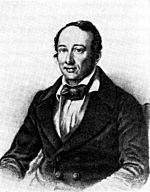Germain Henri Hess facts for kids
Quick facts for kids
Germain Henri Hess
|
|
|---|---|

Germain Henri Hess
|
|
| Born | 7 August 1802 Geneva, Canton of Léman, Helvetic Republic
|
| Died | 13 December 1850 (aged 48) |
| Nationality | Russian-Swiss |
| Alma mater | University of Dorpat |
| Known for | Hess's law, Thermochemistry |
| Scientific career | |
| Fields | Chemistry |
| Institutions | St. Petersburg Academy of Sciences |
Germain Henri Hess (born August 7, 1802 – died November 30, 1850) was a famous Swiss-Russian chemist and doctor. He is best known for creating Hess's Law, which is an important rule in a field called thermochemistry. This law helps us understand how energy changes during chemical reactions.
Contents
Early Life and Education
Hess was born on August 7, 1802, in Geneva, Switzerland. His father was an artist who moved the family to Russia in 1805. There, his father worked as a tutor for a wealthy family. Hess's mother was also a tutor, and because of this, he learned to speak both German and French at home.
In 1817, his family moved to Dorpat, which is now in Estonia. He went to a private school for two years, then to Dorpat Gymnasium, finishing in 1822. In the autumn of 1822, Hess began studying medicine at the University of Dorpat.
Studying Chemistry and Medicine
At the university, the chemistry department taught courses for both medicine and pharmacy students. Professor Gottfried W. Osann gave lectures in German, which was very helpful for Hess. Under Professor Osann's guidance, Hess performed many chemical analyses. He also enjoyed the lectures from the physics and mineralogy professors.
Hess graduated with honors in 1825, earning a doctor of medicine degree. His main project was about "Curative Waters, Especially Those in Russia." After graduating, he was sent to Sweden to meet the famous Swedish chemist Jöns Jakob Berzelius. This meeting made Hess decide to focus entirely on chemistry.
When he returned to Russia, Hess joined a trip to study the geology of the Ural Mountains. Later, he became a doctor in Irkutsk. This was a rule at the time: new doctors had to work in a Russian frontier town. Hess arrived in Irkutsk in August 1826.
Contributions to Chemistry
In 1830, Hess started working full-time in chemistry, doing research and teaching. He later became a professor of Chemistry at the St. Petersburg Academy of Sciences.
Hess's Law and Thermochemistry
His most famous scientific paper was published in 1840. In this paper, he described his important rule about thermochemistry, which is now called Hess's law. This law is a very early version of the first law of thermodynamics, which deals with how energy is conserved.
Hess's Law states that in a series of chemical reactions, the total energy gained or lost only depends on the starting and ending points. It does not matter how many steps are in between or what path the reaction takes. This is also known as the law of constant heat summation.
Experimental and Theoretical Work
Like many scientists of his time, Hess was mainly an experimental chemist. He loved discovering and studying new substances. However, he also became very interested in theoretical questions. He especially wondered how chemical affinity (the force that makes atoms combine) was connected to heat in chemical reactions.
His experiments on different forms of sulfuric acid showed something important. The heat released when these substances formed was always the same. This was true whether the reactions happened directly or through intermediate steps (1840). Hess's work was an early step towards understanding the conservation of energy. He made this discovery two years before another scientist, Julius Robert von Mayer, stated a more general rule in 1842. Hess knew how important his own discovery was.
Law of Thermoneutrality
In 1842, Hess also suggested the law of thermoneutrality. This law says that no heat is given off when neutral salts exchange parts in water solutions. A full explanation for this law came much later, about 45 years later. It was explained by the Swedish chemist Svante Arrhenius using the idea of electrolytic dissociation.
After these two big discoveries, Hess became very important in the growth of chemistry in Russia. His book, Osnovania Chistoy Khimii (Fundamentals of Pure Chemistry), was published seven times. It was the main textbook for chemistry students in Russia until 1861. Hess was also a dedicated teacher and helped many young scientists. He had to retire in 1848 due to poor health.
Later Research and Final Days
Hess also studied minerals. He analyzed a mineral called silver telluride (Ag2Te). This mineral was later named hessite in his honor. He also found that when sugars are oxidized, they produce saccharic acid.
Germain Henri Hess passed away too soon in 1850, at the age of 48, in St. Petersburg. He was buried at the Smolenskoe Lutheran cemetery.
See also

- In Spanish: Germain Henri Hess para niños

